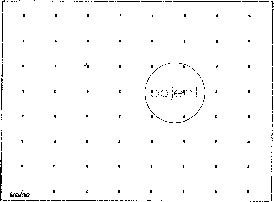
Figure 12:

The ultimate problem was posed by a video recording of the 28Sgr/Titan event made by Ruud Kreuzen in The Netherlands. He used a 20 cm Celestron on a wooden platform of an old church tower, without any motorised tracking device. Again, the sensitivity was such that Titan itself was not visible during the occultation. Even the star was barely visible. Jean Eudes Arlot tried to reduce this video in Paris using his software without any chance of getting a result. Nevertheless, I saw it as a challenge to be able to get a result from it after all. If successful, it most certainly would prove my approach to be right .
Because of the severeness of the motion, it was not possible to use the mask principle of the previous chapter. In fact occasionally Saturn even moved outside the field of view. An array of interspaced points for the complete frame was defined such that at least one point of Saturn would be found if it was anywhere inside the frame (see figure 12 for the principle). The next step is to find the centre of Saturn. For a circular object you can just read two arrays of points from the point you found and determine the edge points as the points where the difference in lightlevel form the previous point is maximum. This way you will end up with four intersection points, from which it is simple to find the centre of the object (figure 13). Using fixed X and Y offsets from this centre point, you can again make the necessary light measurements of the star. In case of Saturn being an ellips, this approach is only valid if the axis' of the ellips coincide with X and Y axis of the pixel grid. In the case of the concerned video this is nearly true, so, only small, if any, deviations are introduced. The resulting curve is shown in figure 14. Although highly noisy the central flash stands out. This result can even be improved combining two separate runs (figure 15). As you can see the noise diminishes and consequently the central flash stands out more prominently. Each run processes only 1 frame out of 5 frames. So the result could be improved even further if all frames were to be processed.
